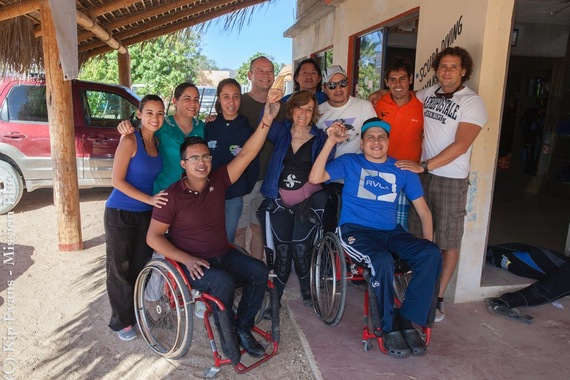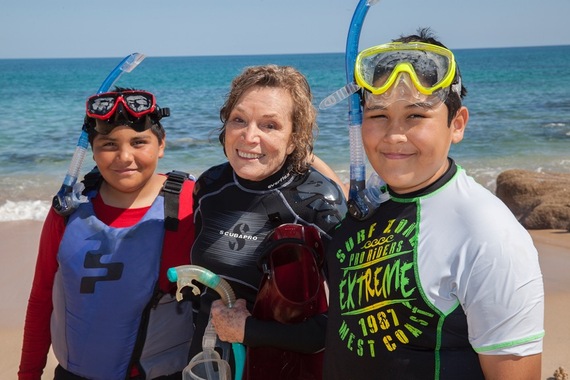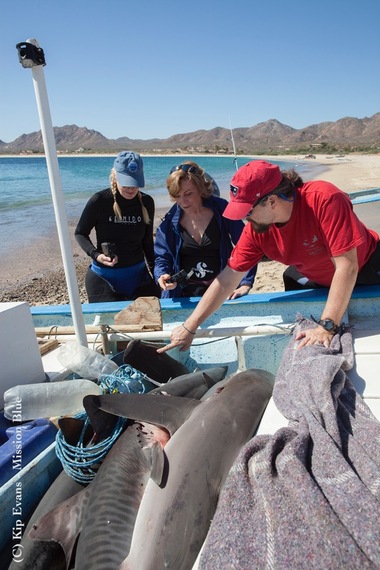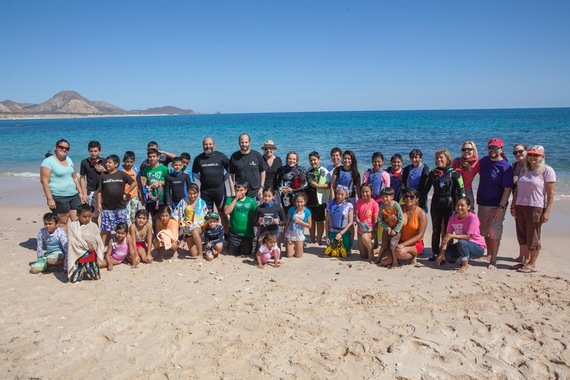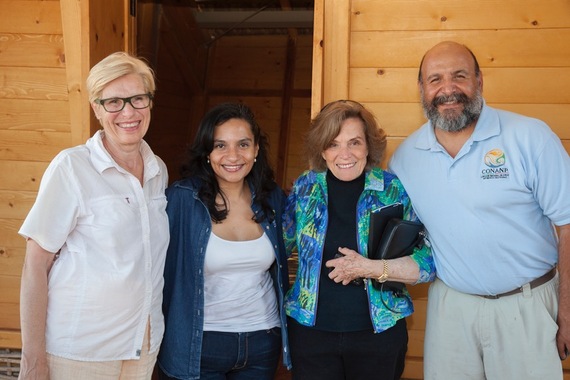On our recent Hope Spot Expedition to Cabo Pulmo Marine Park, located in the Gulf of California Hope Spot, we five discoveries were made.
1. The Ocean is For Everyone
Dr. Sylvia Earle and the Mission Blue team were deeply honored to spend the morning of February 27 with Eduardo Martinez, director of Fundacion Teleton. This Mexican nonprofit works with disabled people--like the three Mexican teens named Fausto, Roberto and Salma who came along to dive with Dr. Earle--their first ever dive in the ocean! Dr. Earle expressed directly to these newly coronated divers her deepest admiration for their courage. The ocean, truly, is for everyone and we have Fausto, Roberto and Salma to look at for proof.
In a vibrant display of youthful enthusiasm, Mission Blue and the Cabo Youth Center also took nearly 30 local children snorkeling with Dr. Sylvia Earle. Many thanks go to ScubaPro for donating the masks, fins and snorkels to the youth of Cabo Pulmo. The snorkel kits will now reside at the Cabo Youth Center where local children can check them out like library books and explore the ocean in their spare time.
2. Sharks Are In Trouble
(Bahia Los Frailes in Cabo Pulmo Marine Park)
On February 27 2016, the Mission Blue team was greeted by a dismal sight as we arrived at Bahia Los Frailes in Cabo Pulmo Marine Park: strewn across the beach were the hacked carcasses of approximately 20 sharks of several species. Sitting on the sand was a box full of shark fins, no doubt destined for Asian markets. How can shark slaughter happen in a marine park that is purportedly "no-take"? Carlos Ramon Godinez Reyes, Director of the Cabo Pulmo Marine Park (CONANP), was with us and questioned the fishermen. They produced a permit and asserted that these sharks had been fished outside of the prohibited boundaries of the park. But how could this be verified? It couldn't. The annual operating budget of the Cabo Pulmo Marine Park is roughly $20,000, according to Mr. Godinez Reyes, making comprehensive enforcement all the more challenging. The issue of shark fishing is complex, on both a conservation and social level, but Dr. Earle said it best as she gazed at the dead sharks: "I'm just as worried about legal fishing as illegal fishing."
Indeed, from wherever these sharks were harvested, the fact remains that shark populations have plummeted in the Gulf of California to the point where a local shark biologist, Dr. James Ketchum, is saying hammerheads are "ecosystem extinct," i.e. there are a few around you'd be lucky to see, but for all intents and purposes, they are no longer a real part of the ecosystem due to low numbers. Studies done in Mexico and elsewhere in the world have concluded that a shark alive in the water is worth anywhere from $250,000 to $2 million dollars through ecotourism and ecosystem services. We will have full video coverage of the shark finning we found in Cabo Pulmo coming next week. Stay tuned.
3. Marine Protected Areas Work... And We Need More
On February 26, the Mission Blue expedition team received a full briefing from Dr. James Ketchum, a shark biologist and lead at Pelagios Kakunjá, a nonprofit shark research organization based in La Paz, BCS, Mexico. Dr. Ketchum pointed to encouraging data, such as the 400% rebound in fish biomass since Cabo Pulmo was declared a no-take marine protected area 20 years ago. However, through analysis of his telemetry data, he also noted that some shark populations were barely registering and had migratory routes that were relatively unknown. In a broader sense, Dr. Ketchum's research shows that marine protected areas are not enough; sensible conservation also calls for the creation of protected migratory corridors. What good is a marine protected area if a female shark goes there and gets fertilized, but then is slaughtered when she leaves the zone to give birth? To get the full skinny on Dr. Ketchum's research and the amazing work his non-profit performs in the Gulf of California Hope Spot, watch the video above.
4. Community Drives Success in the Creation of Protected Areas
(A special thanks goes to dive master Pilu for her leadership.)
We came across it over and over again in talking with the community of Cabo Pulmo: real passion for the Marine Park and a clear understanding that by protecting it, the community is guaranteeing a sustainable future of natural beauty and economic prosperity. Take, for example, the legendary Castro family of Cabo Pulmo, which now operates Cabo Pulmo Divers. The family used to kill marine wildlife--sharks, fish, turtles and the like--to makes ends meet. Yet decades ago, they accepted the challenge of creating sustainable ecotourism instead of harvesting living resources from the ocean as means to secure prosperity. Their investment has paid back in spades and this dedication to marine protection runs deep in the community, from the staff of Nancy's Restaurant to locals we met in the streets.
5. Two Organizations On The Move in Cabo Pulmo
(Deb Zeyen of Baja Coastal Institute, Norma Sanchez of Pronatura, Dr. Sylvia Earle and Cabo Pulmo Park Director Carlos Ramon Godinez Reyes)
A brand new Visitors Center is being constructed right now in Cabo Pulmo thanks to the efforts of Pronatura and the Baja Coastal Institute (BCI) along with other critical support from the local community. This custom designed complex will include a public amphitheater and orient newcomers to the ecological riches that Cabo Pulmo contains and the work required to keep them protected. We were honored to spend time with Deb Zeyen, the Executive Director of BCI, a critical ally whose organization collects scientific data in the Gulf of California Hope Spot and broadcasts findings to drive conservation of this marine haven.

